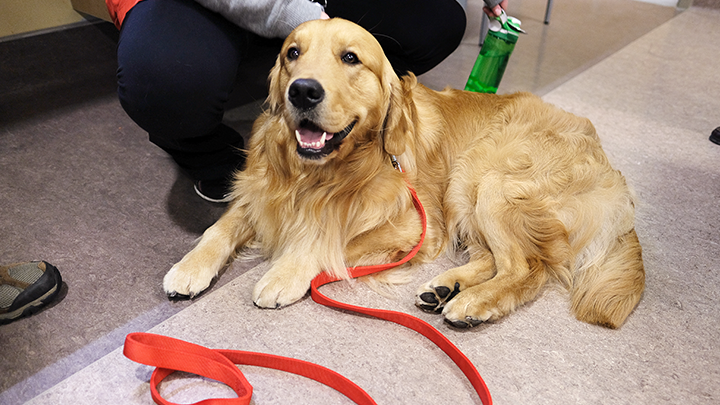
February 27, 2019

Rook is on the job at the South Health Campus emergency department.
Story & photo by Alison Walker
CALGARY — Puppy love has at long last come to the emergency department of South Health Campus (SHC) thanks to two new pilot programs.
This builds on SHC’s long history of supporting pet therapy and pet-visitation programs, says Karen Cameron, an assistant in the Volunteer Resources Program. Over the years, dogs have been brought in to visit inpatient areas and outpatient clinics, and special visits have been arranged to provide comfort to palliative care and mental health patients.
“We had thought before about bringing pet visitations to the emergency room, but we always hit a bit of a stumbling block — would it be appropriate?” she adds. “After several consultations and discussions, we decided to give it a trial run.”
With strong buy-in from emergency department (ED) staff and management — whom Cameron refers to as “dog lovers” — Volunteer Resources launched its ED pilot project last July 5. Since then, staff have welcomed canines with open arms.
“We originally agreed to the program for the patients, to help them cope when they’re in crisis or to feel better about wait times, but it’s had such a positive impact on staff morale,” says Carla Seal-Riemann, unit manager for SHC Emergency. “You can just see the energy lift when one of the dogs walks on the unit.”
In fact, the hounds have become ED celebrities. Staff remember their birthdays, histories and even their favourite snacks. Seal-Riemann adds that staff attendance is higher when the dogs are scheduled to visit, with staff trying to pick up shifts for these days.
SHC partners with three organizations that source, train and provide dogs to the pet visitation programs: St. John’s Pet Therapy Program; Pet Access League Society (PALS); and the Community Therapy Dogs Society. All three provide rigorous training to ensure the dogs have the proper temperament for therapy work. As well, handlers receive training and orientation as AHS volunteers.
At present, three dogs regularly make the rounds at SHC as part of the pilot program – Rook, Gracie and Yukon – and Volunteer Resources is working with its partners to find a fourth.
The dogs have been so well received that the emergency department has asked if Volunteer Resources can expand the role the dogs play in the ER, which led to the creation of a second pilot program called Dog Debrief.
Through Dog Debrief, Volunteer Resources has also arranged for a team of five dogs to be available on-call to comfort team members following a critical incident debrief. A critical incident is one that staff may find more emotional, traumatic or upsetting than usual. Examples include the unexpected death of a child or a mass-casualty incident.
While Cameron hasn’t yet taken the opportunity to personally test out the program, she expresses hope that Dog Debrief will provide a positive outlet for staff dealing with an upsetting incident.
“Emergency department staff deal with so many traumatic things, and the exposure to the dogs really helps them,” says Cameron.
“The dogs bring a lot of smiles — and a lot of happiness — when you’re not expecting to find it.”